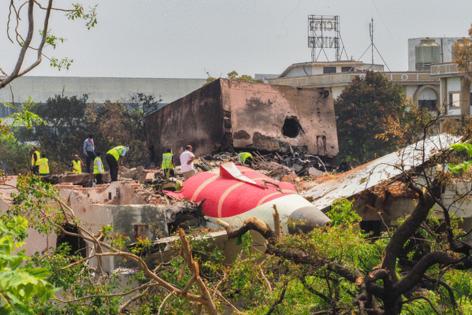Air India Boeing 787 crash spurs speculation, calls for patience
Published in News & Features
It may take months to fully understand what caused a Boeing 787 to crash shortly after takeoff Thursday, killing 241 people in the northwestern Indian city of Ahmedabad.
Regulators from India and the United States will investigate India’s deadliest plane crash in decades, but officials and experts warn that answers won’t come quickly. U.S. Department of Transportation Secretary Sean Duffy said the department is prepared to assist India with the investigation, if needed.
“If there are initial concerns of safety, we will be made aware and we will take action,” Duffy said in a news conference Thursday afternoon. “Whenever one of these planes go down, we take it very seriously.”
So, too, must Boeing.
The incident immediately renewed concerns about Boeing’s 787 Dreamliner, the jet maker’s smaller widebody plane, and the stuttering recovery the aerospace giant has undergone in the 18 months since the last crisis involving one of its jetliners.
While the 787 has never before been involved in a fatal crash, it has been the subject of allegations about manufacturing quality. The 787 jet that crashed was the 26th production Dreamliner to be rolled out of the Everett Boeing factory and was among the first dozen delivered to Air India in 2014.
“Our deepest condolences go out to the loved ones of the passengers and crew on board Air India Flight 171, as well as everyone affected in Ahmedabad,” Boeing CEO Kelly Ortberg said in a statement Thursday.
A Boeing team “stands ready to support the investigation led by India’s Aircraft Accident Investigation Bureau,” Ortberg continued, referring to the Indian organization leading the investigation.
The crash
Video of the crash shows the jet struggling to climb and then descend, its nose up, before crashing less than a minute after takeoff. That faltering ascent led some experts to believe issues with the Dreamliner’s flaps— panels on the wings that extend to increase the wing surface at low speeds, helping a jet lift off the ground — or their configuration may have contributed to the disaster. But until official reports come in, experts can do little more than guess.
Dan Bubb, a former pilot and a commercial aviation historian at the University of Nevada-Las Vegas, said he noticed the flaps’ positions in the video.
“They didn’t seem to be set in the takeoff position,” Bubb told The Seattle Times. “There was talk of an engine failure, but I don’t know. I didn’t see a flock of birds or the engine flameout. It seems to me a catastrophic mechanical failure with the flaps or they were set in the wrong configuration.”
After the crash, extreme heat from the blaze that engulfed the wreckage made rescue efforts extremely difficult, Indian Minister of Home Affairs Amit Shah said Thursday, according to the Ahmedabad newspaper Gujarat Samachar.
“There was no opportunity to save anything,” Shah said.
On the social media platform X, Shah said he was “pained beyond words by the tragic plane crash.” He later posted making a hospital visit to people who were injured on the ground.
Subrahmanyam Jaishankar, India’s minister of external affairs, posted on X that he was “deeply shocked to learn about the flight crash in Ahmedabad. Our prayers are with the passengers and their families.”
Jaishankar is also a member of parliament, representing the Indian state Gujarat. Ahmedabad, where the crash occurred, is Gujarat’s most populous city.
The Seattle Gujarati Cultural Society offered condolences and assistance to anyone affected by Thursday’s plane crash.
“We are all deeply shaken by the heartbreaking tragedy of the Air India plane crash in Ahmedabad earlier today,” the nonprofit said in a newsletter to community members. “As members of the global Gujarati and Indian community, this loss feels especially personal and close to home.”
The Seattle Gujarati Cultural Society President Janmesh Jani said in an email to The Seattle Times that the organization is continuing to monitor the situation and are in contact with community members who may have connections to those affected.
Dreamliner No. 26
Boeing first flew the 787 Dreamliner in 2009, launching a plane envisioned as a radical step forward for Boeing but one that became a money-loser and headache for company. The plane that crashed was manufactured in Everett, according to the aviation analytics firm Cirium, built before Boeing consolidated 787 production in its North Charleston, S.C., factory.
The 787, a fleet that totals approximately 1,175 planes, had never been in a fatal crash before Thursday. As of April, the 787 Dreamliner fleet had carried 1 billion passengers, Boeing said, noting that it hit the milestone faster than any widebody commercial airplane in history.
For pilots, Bubb described the plane as one of the crown jewels in Boeing’s production line.
“They’re just so solid, it’s like they almost fly themselves” he said. “It’s made from different composite materials and it’s really fuel-efficient. Sitting in the cockpit, you’d think you’re in the Starship Enterprise.”
But it has come under scrutiny for quality concerns, including a problem with lithium-ion batteries that briefly grounded the fleet shortly after it launched and, more recently, the discovery of almost imperceptibly small gaps in the connections between fuselage panels that raised concerns about weakening the structure.
Dreamliner No. 26, the plane that crashed Thursday, came soon after the earliest 787 jets, which were called the “ Terrible Teens” and characterized by design flaws, out-of-sequence work and production delays. It underwent three test flights before it was delivered to India in 2014.
Over the past year, the jet was flown daily to destinations on five continents, including to Washington, D.C., in September 2024.
In the past week alone the 787 Dreamliner flew to Delhi; Paris; Frankfurt; Melbourne, Australia; and Tokyo, according to flight data from the flight-tracking company FlightRadar24. The plane’s final flights before the crash were from Paris to Delhi on Wednesday and a one-hour flight from Delhi to Ahmedabad Thursday morning.
Air India used the plane on four flights between Washington Dulles International Airport near Washington, D.C., and Delhi in September 2024. Soon after, Air India began using Boeing 777s for that route.
Sumeet Sabharwal, the captain of the Air India flight that crashed, had 8,200 hours of flying experience, according to the Directorate General of Civil Aviation in India. Sabharwal had worked as a commercial airline pilot for 22 years, BBC reported. The first officer, Clive Kundar, had 1,100 hours of experience.
Both were killed in the crash.
An international effort
The National Transportation Safety Board will send a team of investigators from the U.S. to India to assist the country with the investigation into the crash.
Investigators with the NTSB, the official U.S. representative on transportation-related disasters, will identify if there are any safety deficiencies “affecting U.S. aviation interests” and any safety lessons to be learned to prevent U.S. accidents, the agency said Thursday.
“Given the international nature of air transportation and the leading role the United States plays in developing aviation technology, our participation in foreign investigations is essential to enhancing aviation safety worldwide,” the NTSB said on its website.
The U.K. Air Accidents Investigation Branch said it’s deploying an investigation team to India for support because U.K. citizens were on board as well, according to a news release from that government.
U.S. Sen. Maria Cantwell, D-Wash., cautioned against speculating about the cause of the crash, as did other government officials like Duffy, the DOT secretary.
“This is a devastating loss of life, and my heart breaks for the families and loved ones of those aboard Air India Flight 171,” Cantwell said. “I’ve been in contact with the NTSB, and investigators from India and other countries are just beginning their work. We must let investigators do their jobs and not draw any premature conclusions.”
For Boeing, the crash looms over the company’s attempted turnaround. The company’s share price fell sharply once the markets opened Thursday but leveled off and was almost 5% on the day.
In notes to investors after the crash, several analysts stressed the 787’s strong safety record and argued that any speculation on the cause of the crash would be rash.
“It can often take months to fully understand the causes of a crash, and the implications for Boeing and its suppliers,” RBC Capital Markets said in an investors’ note.
The crash could affect the positive sentiment around the company during the Paris Air Show, the aerospace industry’s premier gathering set to begin Monday. But RBC said it would caution investors not to rush to judgment.
©2025 The Seattle Times. Visit seattletimes.com. Distributed by Tribune Content Agency, LLC.







Comments